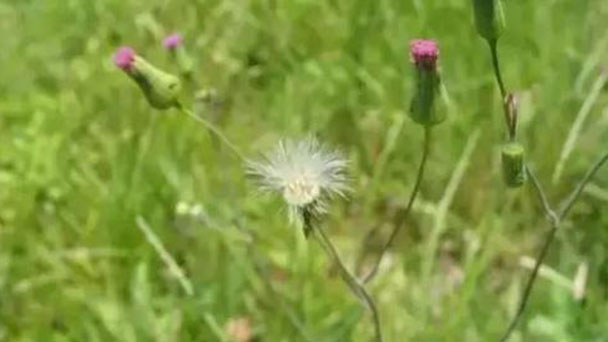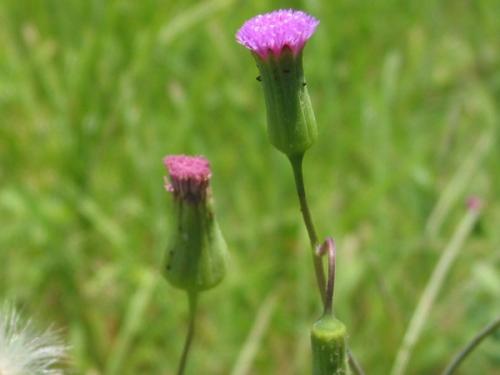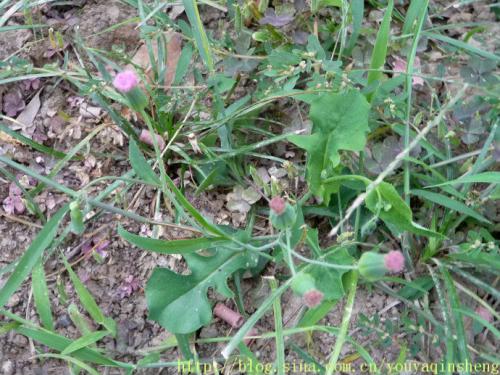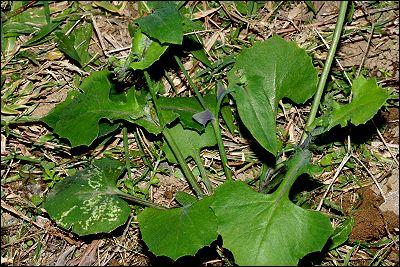Emilia sonchifolia-cupids shaving brush profile
Written by Maggie
Mar 02 2021

Cupid's shaving brush, scientific name Emilia sonchifolia, also called lilac tasselflower, is 20-70cm tall. Cupid's shaving brush stem is solitary, or 2-3 fascicled, erect, terete, rarely branched. Cupid's shaving brush has many basal leaves, fascicular, tiled ground, petiole about 2cm long; Leaf blade is spatulate ovate to ovate-lanceolate, 7 -- 12cm long, 2 -- 5cm wide, apex obtuse, base cuneate extending into narrow wings, margin with irregular coarsely dentate or undulate incisures, dark green above, green or purplish red below, hairy when young, glabrescent or nearly glabrous when old, veins conspicuous; Cauline leaves of Cupid's shaving brush are alternate, leaves smaller and less than the basal leaves, a few sessile. Inflorescences are capitate, arranged into cymes, terminal;Involucre short campanulate, bracts in 1 row, imbricate arrangement.
Cupid's shaving brush picture

Shape features of Cupid's shaving brush
Rhizome
Herbs annual in Cupid's shaving brush, roots vertical. Stems are erect or oblique, 25 -- 40 cm tall, slightly curved, often branched from base, grayish green, glabrous or sparsely short hairy.
Leaf
Cupid 's shaving brush of a leaf thicker, lower leaves densely, the big feather division, 5-10 cm long, 2.5 6.5 cm wide, lobes large, wide triangular oval, apex obtuse or suborbicular, irregular teeth, lateral lobes usually 1, oblong or oblong-elliptic, lanceolate, apex blunt or sharp, with wavy, dark green above, often become purple below, both sides are short curly; The middle stem and leaves of Cupid's shaving brush are sparsely, small, ovate-lanceolate or oblong-lanceolate, sessile, the base of the arrow-shaped stem, the top acute, the whole margin or irregular serrata;
Flowers
Cupid's shaving brush is a head 8 mm long, extending to 14 mm later, pendulous before flowering, erect after flowers, usually 2 -- 5, arranged in a cloth-like arrangement at the tip of a branch; Inflorescences of Cupid's shaving brush are thin, 2.5 -- 5 cm long, bracteate, involucre cylindrical, 8 -- 14 x 5 -- 8 mm, base without bracteoles; Involucral bracts are 1-layer, 8-9, oblong-linear or linear, yellow-green, ca. As long as florets, apically acuminate, margin narrowly membranous, abaxially glabrous. Florets are pink or purple, ca. 9 mm, elongated in tube, gradually enlarged in eaves, 5-lobed.
Fruit
The achene of Cupid's shaving brush is cylindrical, 3 -- 4 mm long, with 5 ribs and intercostal hairs; The crown hair is rich, white and soft.
The ecological habits of Cupid's shaving brush
Cupid's shaving brush likes a warm, cool and humid environment. Its suitable growth temperature is 20-32℃. Cupid's shaving brush is usually grown in loose and humid places, but it is also drought and barren.
Cupid's shaving brush is usually born in hillside wastelands, ridges of fields and roadside, with an altitude of 800-2100 meters. Cupid's shaving brush is cultivated in Beijing, Yisheng.
Cupid's shaving brush growing methods
Fine soil preparation
Although Cupid's shaving brush does not require a high requirement for soil, in order to cultivate strong seedlings, it is appropriate to choose a sandy loam with flat terrain, deep soil layer, good aeration, water and fertilizer preservation, loose soil. Full base fertilizer can be applied, and mature organic fertilizer can be applied 22.5 to 30.0 tons/hour square. Before sowing, loose land should be furred and ridged, with a width of 1.5 meters.
Transplanting engraftment
Sand loam soil with good drainage was selected for planting. Full base fertilizer was applied, and mature organic fertilizer 22.5-30.0 t/h square, urea 150 kg/h square and compound fertilizer 45 kg/h square were applied as base fertilizer. 2 hours before transplanting, the seedlings of Cupid's shaving brush will be watered through the water seedlings, seedlings as much as possible when taking some soil. Planting row spacing is (15-20) cm ×20 cm, drench enough to fix the root water. The direct seeding was divided into 2-3 times of thinning, and the spacing of planting Cupid's shaving brush and rows was the same as that of planting.
Field management
Picking can take about 25 days after planting. During this period, care should be taken to prevent weed growth and soil hardening. Pay attention to loosen the soil often, strengthen the drenching, keep the soil moist. Discover flowering in time to remove. Apply urea 75-150 kg/h square per topdressing for each harvest, and apply it with water to promote the occurrence of new shoots and increase the yield. Rain weather should be timely discharge water, so as not to affect the growth.

Cupid's shaving brush propagation
Seed propagation
Choose fresh, plump red seeds of Cupid's shaving brush. Sowing before the first fine, solid, leveling, pouring permeable, to be slightly dry soil after sowing. Every 667 square meters with a kind of 500 grams, sowing after the cover of a thin layer of fine sand soil, to prevent the wind when the seeds blow away. Cover soil should not be too thick, otherwise affect the emergence rate. During the seedling, pay attention to more water and keep the soil moist.
Rootstock
Cupid's shaving brush propagates with a rhizome. In autumn, winter or early spring, select tender stems with buds in combination with harvest, cut into small sections of 3-7 cm, cut holes according to the row spacing of 25 cm, the depth of 3-6 cm, plant three sections in each hole, finished product shape discharge, and cover with soil or soil mixed compost after planting.
Disease prevention in Cupid's shaving brush
Cupid's shaving brush was originally a wild variety. Cupid's shaving brush has strong vitality, wide adaptability, and strong resistance to pests and diseases. Cupid's shaving brush can also use little or no pesticides under artificial cultivation conditions. The insect pest with more harm commonly has aphid only, once discovered, use net (imidacloprid content is 10%) or aphid net 600 grams/hour square spray can.One of the most harmful diseases is rust, which can be controlled with 1500 times triazolone emulsion after discovery.
The distribution area of Cupid's shaving brush
Cupid 's shaving brush was distributed in China (kunming, yunnan, yao, chuxiong, wide communication, open far, asan, yuxi, dalongkou), guizhou (was Yang, xingyi, enron, book heng, chishui), sichuan, hubei, hunan, jiangsu (yixing), zhejiang (hangzhou, ningbo), anhui (ShuCheng, huoshan, Jin Zhai and mountains in the south of anhui, guangdong, shantou, guangzhou) and hainan (during the county, stability, cliff, lingshui, QiongZhong), fujian, Taiwan.
Cupid's shaving brush is also widely distributed in tropical and subtropical Asia and Africa.
Cupid's Sshaving Brush pattern was taken from Sri Lanka.
Cupid's shaving brush main value
Edible value
Cupid's shaving brush is a wild variety. It is often used as wild vegetables, mainly with tender shoots and tender leaves. Cupid's shaving brush can be fried, served as soup or hot pot material.
Cupid's shaving brush for garden use
Cupid's shaving brush is an annual herb with strong vitality and wide adaptability. The florets are pink or purple and can be used for cultivation and decoration.
Medical use
The whole herbal of Cupid's shaving brush can be used as a medicine, anti-inflammation, stop dysentery, mainly for mumps, mastitis, infantile malnutrition, skin eczema and other diseases.

Latest Updated
- Benefits of Bugleweed - 7 Science-backed Health Benefits
- Bugleweed Dangers & Side Effects - Is It Poisonous?
- How to Plant Evergreen Trees - What You Should Know
- When to Plant Evergreens - Grow Guide for Evergreen Trees
- 12 Wonderful Evergreen Shrubs for Your Garden
- 12 Popular Evergreen Plants with Pictures for Beginners
- When And How To Prune A Lilac Bush Like a Pro
- How to Grow & Care for Lilac Vine (Hardenbergia Violacea)
- Japanese Lilac Tree (Syringa Reticulata) Care & Propagation Guide
- Shumard Oak Pros and Cons - What to Know
Popular Articles
- Winter maintenance of Antirrhinum Majus
- How to Grow Terminalia Mantaly Tree
- How to Grow and Care for Crossostephium Chinense
- How to grow Antirrhinum Majus in spring
- Peristeria Elata (Dove Orchid) Profile: Info & Care Guide
- Underwatered Snake Plant (Sansevieria Trifasciata) - Signs And How To Fix
- How to Care for Brazilian Jasmine Plant (Mandevilla Sanderi)
- How to Grow & Care for Graptopetalum Purple Delight in Summer
- Rosa Chinensis (China Rose): Plant Growing & Care Tips
- How to Care for Baby Sun Rose (Aptenia Cordifolia)